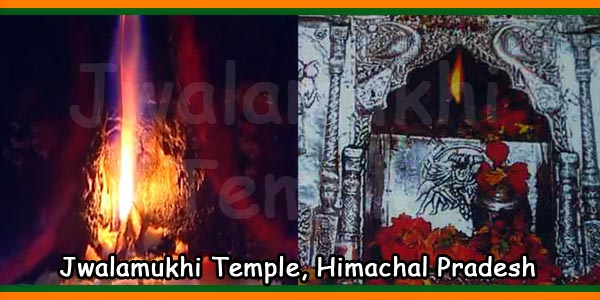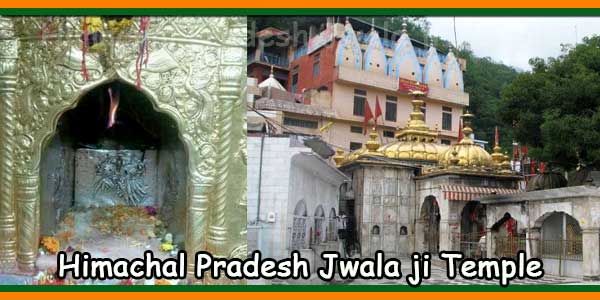Jwalamukhi Temple / Flaming Goddess / Jwala Devi Temple in Himachal Pradesh is one of the Ashtadasa Shaktipeethas and is considered extremely sacred for the Hindus. Jwalamukhi Temple, dedicated to Goddess Jwalamukhi, is situated 30 km south of Kangra Valley in Himachal Pradesh. The unique feature of the temple is there is no idol to worship, natural flames in the temple burn continuously without any fuel and are seen breaking out from a rock side without any external assistance. These flames are worshipped as a manifestation of the nine Goddesses – Mahakali, Maha Lakshmi, Saraswati, Unpurna, Chandi, Hinglaj, Bindhya Basni, Ambika and Anji Devi. The beautiful temple is set against a cliff. The dome of the temple is aureate of gold and has pinnacles. It also has a picturesque folding doorway of silver plate which was gifted by Sikh Raja Kharak Singh. The temple has an Indo-Sikh feel to it.
As per ancient legends, there was a time when demons dominated the Himalayas Mountains and insulted the gods. Gods under the leadership of Lord Vishnu decided to destroy them. They concentrated their divine energy which resulted in huge flames from the ground. From that flame appeared a beautiful young girl who was regarded as Adishakti, the ultimate power of the universe.
Puranas says that the great Mughal emperor Akbar visited and tried to extinguish the flame of the temple. However, when he failed, he willingly submitted to the power of the goddess. He presented a golden chhatri (umbrella) for the goddess which turned into copper when he turned to look at it before leaving the temple.
Maharaja Ranjit Singh paid a visit to the temple in the year 1809. His son, Kharak Singh gifted a pair of silver-plated folding doors to the temple while Ranjit Singh himself gave the gilt roof. Moreover, in the princely era, the work of the temple was managed by the Raja of Naduan. He himself appointed the temple priest. After independence, things changed a lot. The pujaris are now appointed and paid by the government. A part of the money collected by the temple is used to improve the facilities for the visiting pilgrims.
Jwalamukhi Temple Timings:
Summer season: 6:00 AM to 10:00 PM
Winter season: 7:00 AM to 9:30 PM
Jwalamukhi Temple Aarti Timings:
Mangal Aarti on all days – 5.00 AM to 6.00 AM
Bhog Aarti on all days – 11.00 AM to 12.00 Noon
Evening Aarti on all days – 7.00 PM to 8.00 PM
Shalyan Aarti on all days – 9.00 PM to 10.00 PM
Jwalamukhi Temple Timings and Pooja:
- Jwalamukhi Temple gates remain open all days of the week. The visiting hours of this temple change in Summer and Winter.
- The Pooja in the temple occurs in gradual stages. Havan takes place every day and the goddess is offered bhog of Rabri(thickened milk), misry or candy apart from the regular bhog of seasonal fruits and milk.
- Aarti is conducted five times a day where the first aarti happens early morning around 5:00 AM when the temple gates open. This aarti is called the “Mangal aarti ” and takes place just before dawn.
- The next aarti called “Panjupchaar puja” is performed during sunrise. The next aarti is known as “Bhog ki aarti” where the deities are showered with fruits and milk by the devotees as a gesture of saying thank you to the goddess. The next aarti is performed around 7:00 PM and does not hold a specific name.
- The last and final aarti is at 10:00 PM. This special aarti is known as “Saiyan ki aarti” where the bed of Devi is beautifully decorated with flowers and ornaments. The aarti is performed in two phases. The first phase happens inside the main temple and the second happens inside the Sejabhavan. Apart from these five aartis, shlokas are recited daily to the deity.

Jwalamukhi Temple History:
Jwalamukhi refers to the deity with a flaming mouth. As per the legends, the mouth of Sati fell here at the time of self-sacrifice. Ever since the Goddess occupied the place and she manifested in nine flames. After years, one day Raja Bhumi Chand Katoch, a resident of Kangra and a great devotee of Goddess Durga, dreamt of the holy place.
He sent his men to locate the place. With the grace of the Goddess, the site was found and Raja started constructing a temple. It is believed that Pandavas also contributed to the erection of this temple. However, the construction of this temple was completed in the 19th century, when Maharaja Ranjit Singh and his son, Kharak Singh, gave Gold and Silver for the dome and door respectively.
Jwalamukhi Temple Nearby Attractions:
Nagini Mata 4.5 km.
Shri Raghunathji temple 5 km.
Ashtabhuj temple 1 km.
Nadaun, several old temples and ruins of old temples built during the princely rule of Karota Rajahs 12 km.
Chaumukha Temple 22 kms via Nadaun. Lord Shiva temple with a four-faced image. Chaumukha temple has four temples, of which three doors are permanently closed.
Panj Teerthi and Mahakaleshwar 9 km and 28 km via nadaun.
Bagulamukhi temple in Bankhandi 36 km.
Haripur 45 km.
Mangarh 37 km, an octagonal fort named after Raja Man Chand on top of a hill. There is an ancient temple built by Pandavas.

How to Reach Jwala Ji Temple:
By Air:
Kangra Airport is the nearest airport which is 46 km to Jwalamukhi Temple. This airport connects only three cities i.e Delhi, Chandigarh and Kullu. Chandigarh International Airport is the nearest International Airport which is 195 km.
By Rail :
Kangra railway station is just 32 km from Jwalamukhi Temple.
By Road :
Jawalamukhi Temple is 31 km from Kangra and 54.2 km from Dharamsala, One can find a bus service from Pathankot. If going by car from Delhi/ Chandigarh to Dharamshala/ Kangra follow Una-Amb-Mubarikpur, follow NH20A, Chintpurni, Dehra Gopipur, turn right on SH 22 to reach Jwala ji, come back to Ranital on NH88 to go to Kangra.
Jwala Ji Temple Address:
Jawala Ji Temple Road,
Kohala,
Jawalamukhi,
Himachal Pradesh – 176031.
Phone Number: 01970 222 223
